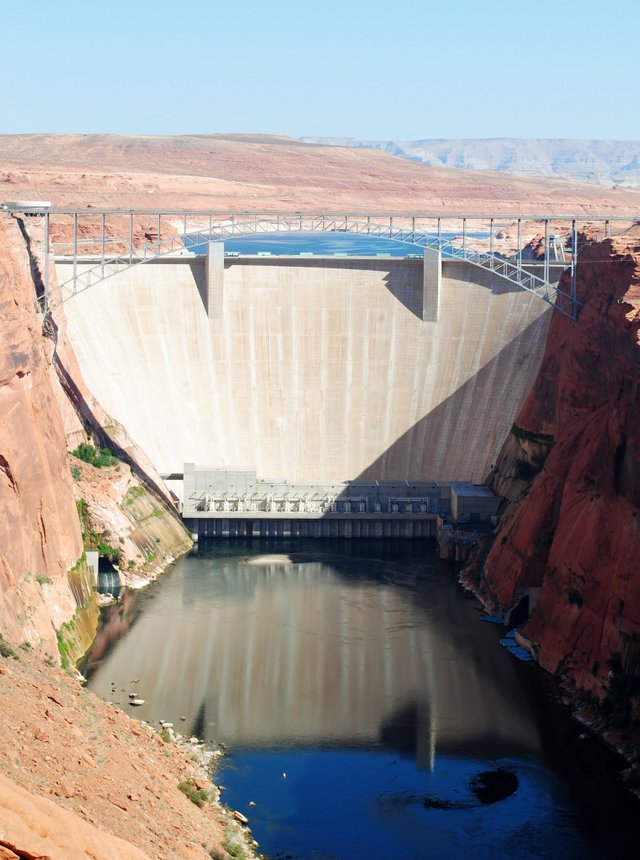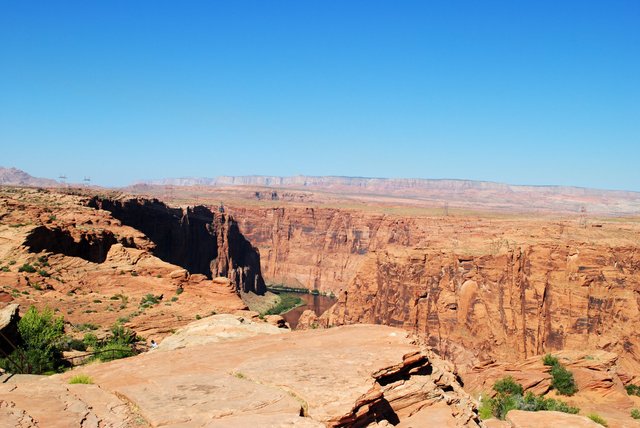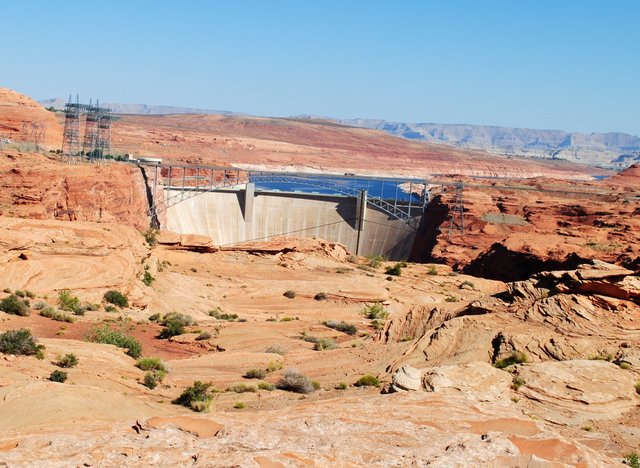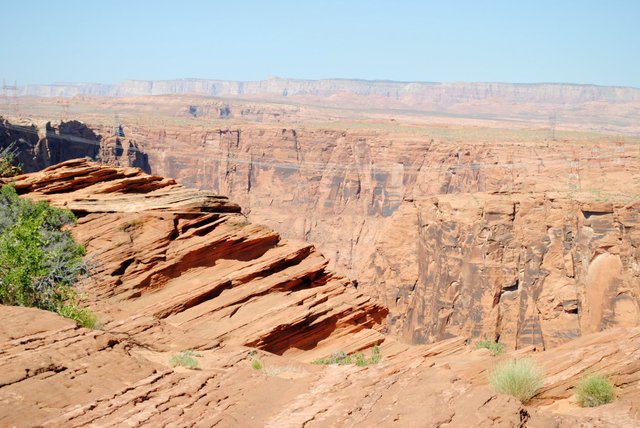Environmental Issues: Glen Canyon Dam
The upper Colorado River and it’s tributaries run mostly in remote country. The land is arid and wild with many spectacular canyons that are often inaccessible.
Glen Canyon Dam
It’s all about the silt. The upper Colorado and it’s tributaries cut through sandstone and limestone through much of their length and produce thousands of tons of silt every year. Glen Canyon Dam at Page, Arizona stops much of this silt, the water flows out clean and green. Which isn’t as good as you might think.
Glen Canyon is thought to trap 45 million tons of silt EVERY YEAR. The Sierra Club estimates the total useable life span of the Dam to be less than 100 years-The Bureau of Reclamation estimate is 500 to 700 years.
It’s quite simple: As the volume of silt increases the volume of Lake Powell decreases by a like amount. The silt falls out in the slow water behind the dam, so the degradation of the reservoir is running from the north end to the Dam at the south. When the silt reaches the base of the dam there will be trouble. If the Dam lasts that long.
There are engineering problems with the siting of the Dam itself. The sandstone cliffs are just barely enough to stand up to the normal pressure exerted by the dam. There was a huge flood event in 1983 that very nearly overtopped Glen Canyon Dam and actually caused the footings for the dam to shift. In other words, the dam very nearly failed.
Which would be catastrophic for the river and the 40 million people that rely on it for drinking water. Glen Canyon is built in a sandstone canyon and has actually moved a teeny amount. That is a bad thing for the engineers that designed it and for the dam itself. There are now problems with the spillway gates which are essential in flood control. Not big problems, yet.
Should Glen Canyon fail it might be disastrous for Hoover Dam at the other end of the Grand Canyon. The reservoir behind Glen Canyon is significantly larger than the reservoir behind Hoover Dam.
What can be done? Dredging silt from somewhere behind Glen Canyon is a last ditch option. Where do you put 45 million cubic yards of silt? Every year? It would be a monumental dredging project and an ecological disaster to the river that provides water to the entire South West United States.
You may remember from earlier issues that Glen Canyon was a compromise location, and the real start of the American environmental movement. Typically of most compromises it isn’t an ideal location from any perspective and represents one of the largest potential ecological catastrophes that I know of.
The Likelyhood
The chances of Glen Canyon Dam being the biggest ecological disaster in this century is quite good in my mind. Like maybe 2% per year. It’s almost certainly when something really bad happens there, not if something bad will happen there.
Glen Canyon will hopefully fail slower rather than faster. The exception being the one in 100 year snow melt in the watershed. The last time it happened (1983) the reservoir wasn’t full from the original construction and it still very nearly overtopped. With 45 million tons of silt making the reservoir smaller by the same volume. It’s an explosive combination.
Conclusion
What can be done? Not much. I can’t see dredging as a viable option, the quantity is just too big. If you could get it out of the basin, where do you put it? Remember that it may be significantly contaminated soil from all the upstream mining.
Glen Canyon Dam is going to fail. Whether it fails very slowly by just filling the resivoir with silt of at a more explosive rate by over topping or shifting position is the question at this point. Either way it's going to be a horrible mess for the next generations to deal with.
If you are moved to action by what you’ve read and need to do something you can support the Grand Canyon Trust and tell your congressman to support the Grand Canyon Centennial Protection Act.
I’m going to stick with the Colorado River (and it’s tributaries) as we look at the environmental concerns that dog the whole drainage basin in my next post. Thanks for following along!
All words in this post are mine. The photographs are either sourced properly or taken by me and used courtesy of the author. Some have been published previously
You want some really cool stuff? Check these authors, they will not disappoint.
@broncofan99 Sports Teaching Fishing BBQ. Not necessarily in that order.
@morkrock Music Games Stinging Politics. Don't go here with thin skin.
@princessmewmew Food Antiques Food Life Food Cats. Anything of beauty could show up here.
@soyrosa Great Photographs and Insights for us All
@enchantedspirit Astrology and much more. Detailed analysis and more with grace and humor...





This is really interesting. It is awesome how much power rivers and streams have and how they can change the environment. We have an oxbow lake near where I grew up and it is always awesome to look at the overhead map to see how that was created. I also remember a book from when I was a kid that showed the original location of Niagara Falls and the current location today given how it eats away at the rock below it. Crazy stuff.
Water is powerful. It can be kinetic or passive, but the power is real! I think the next post in the series will have some genuine oxbows in it, in two separate rivers. Pretty impressive.
Goodness - I'm sure greater minds than mine have pondered this question. It's a shame you can't just Scotland some of your sunshine in exchange for our rainwater. We have so much to spare!
It looks so still and beautiful in those photos. The colours and the heat haze remind me the desert regions of Egypt.
If somebody has thought of an answer to my question, I haven't heard it. Even a bad answer. I don't like where this is going to go...
Hmmmm. More rain would mean more silt, but I'd vote for the Scots exchange.
INteresting, scary and somewhat crazy , sounds like a disaster just waiting to happen
It is a disaster that is absolutely going to happen. Will it be fast or slow? Deadly or safe? Those are all that's left to answer, really. And when, of course.
Yes I got that from your post, I hope they try and take some actions on it, and not just cover their eyes and hope for the best
To listen to the audio version of this article click on the play image.

Brought to you by @tts. If you find it useful please consider upvoting this reply.
You got a 14.61% upvote from @ocdb courtesy of @bigtom13! :)
@ocdb is a non-profit bidbot for whitelisted Steemians, current max bid is 40 SBD and the equivalent amount in STEEM.
Check our website https://thegoodwhales.io/ for the whitelist, queue and delegation info. Join our Discord channel for more information.
If you like what @ocd does, consider voting for ocd-witness through SteemConnect or on the Steemit Witnesses page. :)
Unfortunately, many believe that hydropower generation is a safe and sustainable form of energy generation, but that's really not the case. It just causes more issue's in the long run and damages habitat the day building begins. I hope this practice stops.
Thanks for the well written very informative article.
Posted using Partiko Android
In some cases, in some places, it probably makes some sense. Glen Canyon is NOT one of those places. A compromise location that just doesn't check any boxes. It's going to fail.